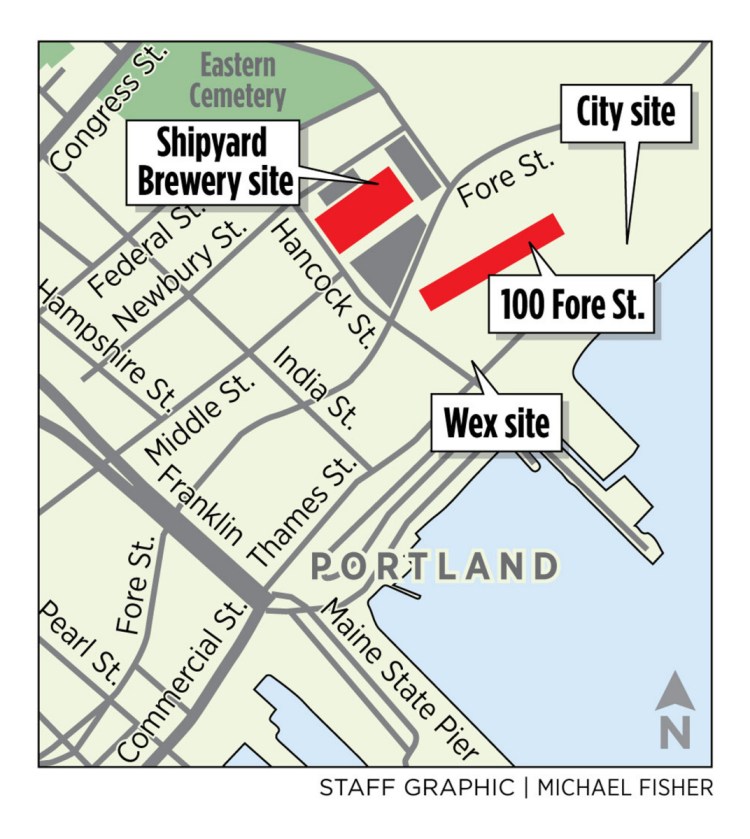In the next three years, four new developments are expected to go up in a two-block area around Fore Street in Portland’s East End, including a hotel, office buildings and parking garages.
Taken together, the new buildings are estimated to attract at least 1,151 vehicle trips during peak commuter hours, about four times what the four properties currently generate.
City staff members are trying to determine the best way to mitigate the influx of traffic by bundling all four developments in a required traffic modification permit from the state.
Permits are typically issued for individual developments, but that would have miscalculated the overall impact, said Jeff Levine, the city’s director of planning and urban development.
“By bundling them it allows us to capture those impacts and get a sense of how to mitigate their impacts,” he said.
In the past four years, about 17 residential and commercial buildings have been built, are under construction or are planned in the neighborhood between downtown Portland and Munjoy Hill.
Rapid new construction and redevelopment in the India Street neighborhood and the city’s eastern waterfront have sparked concerns from neighbors and a group of waterfront advocates. The impact of more personal vehicles on already crowded streets is especially worrying.
“Traffic is getting worse on Franklin Arterial,” the major connection from the East End to Interstate 295, said Maggy Wolf, who lives on St. Lawrence Street on Munjoy Hill.
“I’m very concerned about traffic, idling and pollution,” Wolf said. “It’s very discouraging. I think the city has been very shortsighted about all this development.”
The combined traffic permit is a way to proactively address the anticipated traffic, Levine said. It is also a dry run for an impact fee system planned by the city that would require developers to pay to mitigate traffic and other effects of new construction.
“The idea is to come up with one combined set of improvements that need to be made,” Levine said, “and how we can assign the cost of these appropriately.”
Of the four projects covered by the permit, the new headquarters of payment processing company Wex is the furthest along. The building, at the corner of Thames and Hancock streets, is due to be finished early next year. Once finished, the four-story building will have space for 400 Wex employees and retail space.
The company plans to shuttle employees in from satellite parking lots and encourage carpooling, among other things, to reduce its impact, said spokesman Rob Gould.
“We are definitely a large employer going in there,” he said. “There are others, and hopefully everyone will be participating in the same way.”
Other developments include a redevelopment of the Shipyard Brewery property bordering Hancock, Newbury, Fore and Mountfort streets into a 105-room hotel and offices for Vets First Choice, an online pharmacy company, plus retail and a 340-space parking garage.
Just next door, developer Jonathan Cohen plans to build a fitness center and office complex with a 600-vehicle parking garage at 100 Fore St., the building that currently houses Hamilton Marine and other businesses.
Rounding out the quartet is a small city-owned vacant lot at the end of Thames Street. The best use for the space would be a three-story, 72,000-square-foot office building, according to a city assessment. The city intends to solicit bids for the property by early 2019.
The concentration of new buildings means the city can coordinate its traffic plan, Levine said. That could mean sharing space in one to two parking garages instead of having individual parking for each project, increasing transit links and pedestrian options, and considering off-site lots.
“I think there is going to be a lot of people going to these sites,” Levine said. “We are going to try and push a multi-modal approach.”
Portland’s traffic proposal will be reviewed by the Maine Department of Transportation, which will work to come up with mitigation solutions, said Randy Illian, the department’s traffic engineer for southern Maine. The scale of the permit is not unusual, Illian said. Developments like the new Idexx headquarters and Rock Row development in Westbrook and the Falmouth Center complex on Route 1 in Falmouth have equal or higher added traffic.
Portland is taking the right approach by bundling the four developments, Illian said. Assessing the traffic impact of each development individually would be “extremely difficult,” he said. “Putting them together gives you the ability to analyze a larger area and the larger issue of getting traffic and people in and out of the area.”
Send questions/comments to the editors.




Success. Please wait for the page to reload. If the page does not reload within 5 seconds, please refresh the page.
Enter your email and password to access comments.
Hi, to comment on stories you must . This profile is in addition to your subscription and website login.
Already have a commenting profile? .
Invalid username/password.
Please check your email to confirm and complete your registration.
Only subscribers are eligible to post comments. Please subscribe or login first for digital access. Here’s why.
Use the form below to reset your password. When you've submitted your account email, we will send an email with a reset code.